Brisbane is a city in the midst of rapid change, with major developments across the city set to completely transform the Queensland capital by 2022.
More than $10 billion worth of projects are currently under construction, ranging from the Queen's Wharf casino and entertainment complex, Howard Smith Wharves redevelopment and Brisbane Quarter in the CBD, to the new parallel runway at the Brisbane Airport.
More QLD News Videos
Brisbane: 2016 to 2030
Brisbane will be transformed by a series of multi-billion dollar projects over the next 14 years.
All those big projects began as big ideas. But not all big ideas turn into big projects.
Here, we look at 11 major Brisbane projects that did not progress beyond the planning stage.
Brisbane Central

Brisbane Central would have been the tallest tower in the world. Photo: Fairfax Media
Perhaps overcome with guilt for the shameful destruction of the Cloudland Ballroom and Bellevue Hotel, then-Queensland premier Sir Joh Bjelke-Petersen embarked on a mission in 1986 to build a truly iconic landmark for Brisbane.
And the controversial premier, who was about to become embroiled in a corruption scandal and subsequent Fitzgerald Inquiry, aimed sky high.
Brisbane Central, on the intersection of Edward and Ann streets (opposite Central train station and the Palace backpackers' hostel) would have replaced Chicago's Sears Tower as the tallest building in the world.
The 107-storey Brisbane Central would have dominated the city skyline at 450 metres, more than three times taller than the 148-metre Riverside Centre, which was the city's tallest at the time.
After Brisbane Central received approval, excavation work began at the site but did not get much further than a hole in the ground.
Developer John Minuzzo's proposal was said to be the beginning of the end for Sir Joh's controversial iron-grip rule over Queensland.
The tower could not be built today, due to the city's aviation-enforced 274-metre height limit.
Lord Mayor Graham Quirk has called for a rethink on that limit.
Even if Brisbane Central was built, it would have lost the "world's tallest" honour in 1996, when the 452-metre Petronas Towers were completed in Kuala Lumpur.
The current record-holder, Dubai's Burj Khalifa, is 828 metres high.
Lang Park

The 1993 plan for Lang Park redevelopment. Photo: Fairfax Media
Stung by the departure of the Broncos to ANZ (formerly QEII) Stadium, Lang Park opened its new $27 million western grandstand in 1994, ushering in the Suncorp Stadium era.
It was built to keep rugby league's showcase State of Origin at the spiritual home of the game, against a concerted Brisbane City Council campaign to have all matches moved to its ANZ Stadium at Nathan.
But the Castlemaine Street stand was only stage one of the initial plan, which would have seen the old Ron McAullife Stand retained and new stadium seating to replace the northern and southern terraces.
Sail-like shade cloth would have provided some protection from the elements.
With Brisbane in line to host football matches as part of the Sydney 2000 Olympic football matches, the redevelopment of Lang Park became a political football throughout the 1990s, with Labor at a state level clashing with the then-Coalition and Labor lord mayor Jim Soorley.
Soorley wanted all matches moved to ANZ Stadium. The Coalition came up with plans for a new stadium at Hamilton (see below). Labor wanted Brisbane's new state-of-the-art stadium to be built at Lang Park.
The revolving door at Parliament House, which saw the Goss Labor government replaced by the Borbidge coalition government replaced by the Beattie Labor government, saw several changes in stadium policy.
In the end, the Gabba received a significant upgrade to host the Olympic matches, leaving football without a legacy ground in Brisbane.
Suncorp Stadium was eventually redeveloped into a 52,500-seat stadium that opened in 2003 and was widely considered the best rectangular stadium in the country.
Rivercity Stadium
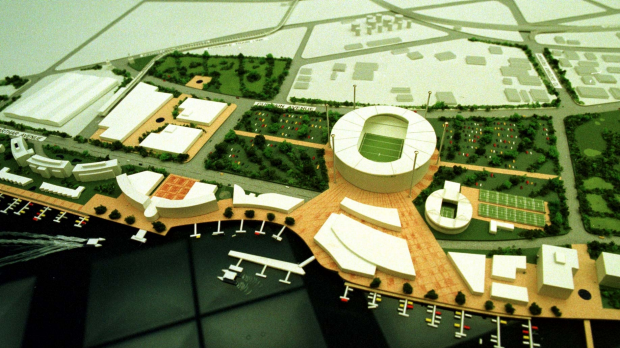
A model of the proposed Rivercity Stadium complex at Hamilton. Photo: Robert Rough
The 1990s quest for a Brisbane "super stadium" saw the Borbidge coalition government come up with a 65,000-seat venue to be built by the river at Hamilton.
The $170 million Rivercity Stadium, part of a wider $900 million Hamilton residential development, was set to be Brisbane's answer to Sydney's Olympic precinct, with tennis and basketball to also have bases at the 84-hectare site.
The cost of building the stadium would have been offset by commercial developments in the precinct, but it was not without controversy.
The proposal drew criticism from some quarters for potential traffic and flight path issues, with the Brisbane Airport a near neighbour of the proposed stadium.
The election of the Beattie Labor government in 1998 blew full-time on the Hamilton proposal.
The area has since been transformed into the Portside precinct, including a cruise ship terminal, restaurants, the Eat Street Markets and residential developments.
Brisbane Skypoint

Skypoint was proposed for Mt Coot-tha in the 1990s. Photo: Supplied
It was meant to be Brisbane's answer to the Eiffel Tower, a defining landmark that would be synonymous with the city.
In the end, the 1997 plans for the $55 million, 215-metre Skypoint Tower on Mt Coot-tha amounted to nothing.
The tourism and telecommunications tower, which would have been built on council-owned land occupied by the ABC and SBS broadcasting tower, was to include viewing platforms, a restaurant and an "alternative reality" theatre.
It was hoped Skypoint would have replaced the other broadcast towers on Mt Coot-tha, which would have, in effect, decluttered the mountain.
The plans, which never gained significant public support, were scrapped in 1998 due to the Asian financial crisis.
Vision and Trilogy
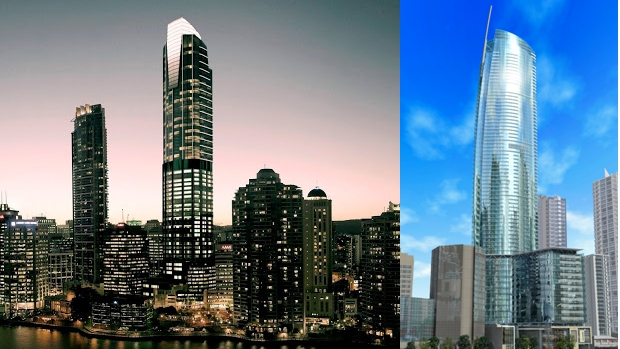
The Trilogy (left) and Vision (right) towers both fell victim to the GFC. Photo: Supplied
Two landmark buildings on nearly opposite sides of the CBD were set to transform the Brisbane skyline, until last decade's global financial crisis hit.
Vision was to be a curved, 283-metre skyscraper with an observation deck, 13 floors of commercial space and 376 residential apartments over 72 floors.
Trilogy would have included 30,000 square metres of office space, along with 192 hotel apartments and 109 residential units.
A large, solar-powered beacon at the top of the tower would have illuminated at night.
Construction started on Vision, but did not pass the excavation stage. The resulting huge hole in the ground sat dormant after developer Austcorp went into receivership in 2009.
The eight-storey hole famously filled up with water during the Brisbane flood of 2011. Billbergia's Brisbane Skytower is currently under construction on the site.
Trilogy did not get as far advanced as Vision, with the project scrapped in 2011 due to a lack of interest in the office component of the tower.
Grocon's 480 Queen Street, with anchor tenant BHP Billiton, opened on the Trilogy site in 2015.
Holy Name Cathedral
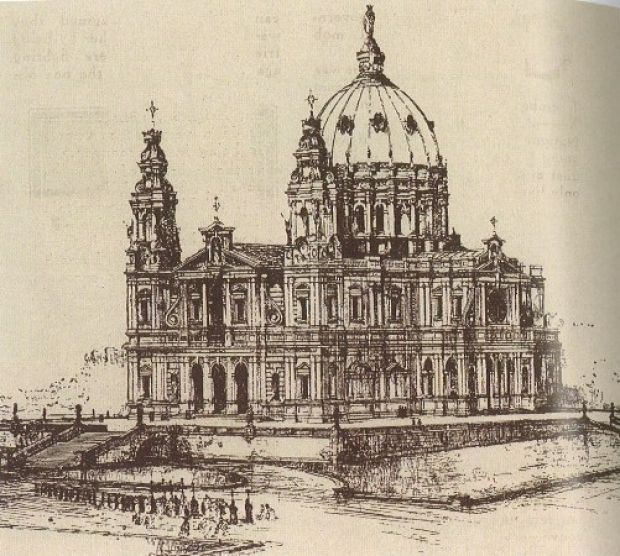
The proposed Holy Name Cathedral in Brisbane. Photo: Catholic Archdiocese of Brisbane
The late Brisbane Catholic Archbishop James Duhig had a vision for Fortitude Valley – a cathedral that would have been the largest of any denomination in the southern hemisphere.
The Holy Name Cathedral, which would have been large enough to accommodate 4000 worshippers, would also have been the single biggest cathedral to be attempted in any part of the world for 300 years.
An 82-metre cupola would have towered over the imposing building, which Duhig championed during his 48-year tenure as Archbishop between 1917 and 1965, and would have dominated the northern end of the CBD.
But a year after its foundation stone was laid, the Great Depression hit in 1929. Then came World War II. Then the increased traffic that would have impeded traffic.
Then there were the rumours that money sent to Rome to be blessed never made it back to Brisbane. Whether that was based in reality, or simply an urban myth, remained unknown.
The Catholic Church sold the site for $6 million in 1982 and, almost two decades later, the Devine-built Cathedral Place apartment complex was completed in 1999.
The Holy Name Cathedral is represented in a piece of public art – an inverted cupola "reflecting" the clouds – not far from the site.
North Bank

The proposed North Bank development would have been built out beyond the Riverside Expressway. Photo: Supplied
Before Star's Queens Wharf casino and entertainment precinct, there was the Bligh government's ill-fated North Bank proposal, which had to be scrapped due to its impact on the Brisbane River.
Then-deputy premier Paul Lucas oversaw the design process in June 2008, which aimed to fix what he described as the "urban environmental vandalism" that was the Riverside Expressway.
The $1.7 billion commercial and public complex would have jutted about 70 metres into the Brisbane River and was billed as a complementary precinct to South Bank.
By October, the proposal was dead, after the government's inquiry by design process found 93 per cent of people did not approve of the project.
It would have included a platform extending over the Brisbane River, beyond the Riverside Expressway, that would have included buildings ranging from 16 to 30 storeys.
Kangaroo Point pedestrian bridge

An artist's impression of a proposed Kangaroo Point pedestrian bridge between Thornton Street and Edward Street. Photo: Richard Kirk Architect
The Goodwill and Kurilpa pedestrian and cycle bridges looked set to have a new inner-city companion three years ago, with a new Brisbane River crossing confirmed and seemingly set for construction.
The proposed 395-metre Kangaroo Point Bridge would have connected the intersection of Alice and Edward streets, near the Stamford Plaza hotel, with Thornton Street at Kangaroo Point.
The bridge would have been suspended off 50-metre masts, been four metres wide and had a 11.4-to-12.7-metre clearance over the river.
The bridge was considered so important it was included in Brisbane City Council's 2014 CBD master plan as one of its priority projects.
Another measure of its importance was that the council was so keen to build the new bridge that Lord Mayor Graham Quirk vowed in 2013 it would go it alone in funding the $120 million dollar project.
Two years later, Quirk's enthusiasm waned as he scrapped the proposal in his 2015 pre-election budget in favour of suburban projects.
The BaT Tunnel

The scrapped BaT Tunnel would have catered for both buses and trains. Photo: Supplied
The Newman government's controversial decision to scrap the approved Cross River Rail project in favour of its own version, which would have also accommodated buses, ultimately backfired on south-east Queensland commuters.
The LNP insisted its version took Brisbane's bus congestion problems into account, which was something Cross River Rail failed to do.
A naming competition was held and, eventually, the BaT (Bus and Train) Tunnel came out victorious, despite a competition stipulation that ruled out acronyms.
But a change in government came with a change of plans, with the Palaszczuk state Labor government committed to a revised Cross River Rail.
The BaT Tunnel had the support of the LNP Brisbane City Council administration, but deputy mayor Adrian Schrinner has since conceded its demise was a blessing for Brisbane commuters, in light of the council's planned Brisbane Metro.
South Bank 2

South Bank 2 would have extended the parklands around Kurilpa Point. Photo: Supplied
Prior to losing power in the 2012 Newman landslide, then-premier Anna Bligh proposed a 27-hectare western expansion of South Bank along Kurilpa Point.
The project would have included a possible national Indigenous museum, an Olympic-sized pool, an entertainment, retail and dining precinct and more riverside parkland.
It would have required the removal of the Parmalat milk factory and the inclusion of residential and commercial buildings to offset the cost.
Hope Street and Montague Road would have been transformed into James Street-style destinations.
But a change in government came with a change in priorities, and South Bank 2 never got beyond the proposal stage.


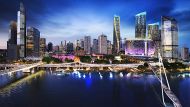







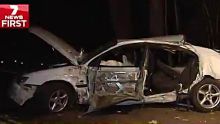





20 comments
New User? Sign up